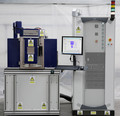text to clipboard
Development consortium targets smarter surface coating
physics, software and thin-film experts pioneer new intelligent approach to sputter coating
Aurora, IL, June 25, 2015 --- A smarter approach to applying advanced thin-film coatings to high value engineering products is being developed by Teer Coatings, Cobham Technical Services and The Open University. The collaborative project, which is co-funded by a $900,000 award from Innovate UK - the UK's Innovation Agency - will develop a groundbreaking practical tool for simulating sputter coating, to deliver a right-first-time process.
The development project brings together experts on non-equilibrium plasma physics, computer-aided engineering software for modeling and simulating electromagnetic and related physics effects, and the design and use of the physical vapor deposition (PVD) magnetron sputtering tools to apply coatings that are important in a wide range of high value manufacturing applications. The key aim is to develop a practical software-guided approach to thin-film coating that is both accurate and fast. This tool will provide an intelligent and automated analysis of a proposed deposition process that will help users optimize the performance of a coating tool and the characteristics of a surface coating applied to workpieces. Such an approach will potentially eliminate the need for prototyping and trials, and will be relevant to intelligent and optimized surface coatings, enabling performance advances in a wide range of engineering sectors.
The collaborative development project will run until September 2016. A team from The UK's Open University will advise on the physics of the magnetically-confined plasmas that are generated in magnetron tools to vaporize coating materials for deposition onto the workpieces, and provide accurate feedback on the actual performance of the new software-guided process.
Cobham Technical Services - developer of the Opera finite-element analysis simulation tool-chain for modeling, simulating, analyzing and auto-optimizing electromagnetic effects - will develop application-specific solvers for its software. These will provide the means for users to model the entire process, from the plasma field, via ion bombardment of the 'target' coating material, to subsequent deposition. The software will also take into account the properties of the vacuum processing chamber, including the magnetic fields and substrate movement.
The project is led by Teer Coatings, part of the Miba Coating Group. As this company manufactures thin-film deposition tools and provides specialist coating services, it is ideally placed to evaluate the new software-guided approach by using it in conjunction with its magnetron tools, and validating its efficiency on a very broad variety of workpieces - from metal cutting tools to medical implants.
"Most magnetron sputtering tools today have been developed by drawing on the practical experience of designers," says Dr Kevin Cooke of Teer Coatings. "The same is true for magnetron coating services - machine operators see a broad range of workpieces and know from experience the best way to position them, to move them in the chamber during coating etc., to achieve good results. Prototyping cycles and trials are invariably employed to test an approach before getting to the finished result. The intelligent software-guided simulation capability targeted by this project will help sputtering tool developers and users to eliminate prototyping and deliver smart, right-first-time coating solutions."
The software-guided approach also offers the opportunity to dramatically reduce the costs associated with sputtering target materials. It is common for less than half of each sputtering target to be depleted before replacement, because of uneven wear. Increasing target utilization by just a few percent has the potential to save the coating industry hundreds of millions of dollars annually in material costs.
Many advanced engineering components such as bearings, turbine blades, valve parts and electronic circuits are given special surface treatments to improve performance, in terms of characteristics such as resistance to wear, lubrication, biocompatibility and electronic properties. These surface coatings are often extremely thin, and can be less than 1/100th of the diameter of a human hair, but often need to survive and function in harsh environments, such as in a turbo-charger or at the tip of a cutting tool.
About Innovate UK
As the UK’s innovation agency, one of the main roles of Innovate UK is to achieve business and economic growth for the UK. One way the organization supports this is through funding innovative Collaborative Research and Development (CR&D) projects. CR&D encourages businesses and researchers to work together on innovative projects in strategically important areas of science, engineering and technology – from which successful new products, processes and services can emerge, contributing to business and economic growth. www.innovateuk.org
ENDS
For further information please contact Lois Lee at:
Cobham Technical Services, 1700 N Farnsworth Ave Aurora, IL 60505, USA
t: (630) 851-1734
f: (630) 851-2106
vectorfields.info@cobham.com
www.cobham.com/technicalservices
About Teer Coatings
Teer Coatings Ltd. (TCL), part of Miba Coating Group, develops individual coating solutions for components and is also a leader in the building of coating machines. We specialize in physical vapor deposition (PVD) coatings and have one of the world’s most comprehensive coatings portfolios. We are also firmly committed to research and development and are heavily geared to progress and innovation, and particularly welcome complex challenges. Customers come to rely on our tailored, innovative solutions and extensive product range. http://www.teercoatings.co.uk
About Cobham
Cobham protects lives and livelihoods with its differentiated technology and know-how, operating with a deep insight into customer needs and agility. The innovative range of technologies and services solve challenging problems in harsh environments across commercial, defense and security markets, from deep space to the depths of the ocean, specializing in meeting the growing demand for data, connectivity and bandwidth. Employing more than 12,000 people on five continents, and customers and partners in over 100 countries, with market leading positions in: audio, video and data communications, including satellite communications; defence electronics; air-to-air refueling; aviation services; life support and mission equipment. www.cobham.com/technicalservices
The UK's Open University - Department of Physical Sciences
The Open University’s Department of Physical Sciences is a lively and innovative department that has grown from a merger of the former Department of Physics and Astronomy with the Planetary and Space Sciences Research Institute and the Planetary Surfaces Group in 2012. The Department comprises four sub-groups: Astronomy, Physics, Planetary and Space Sciences and has around 80 staff and 70 research students drawn from across the globe, mostly based in the Robert Hooke Building on the Walton Hall campus in Milton Keynes, UK. The Physics Discipline has around 20 members of staff, 12 research students and at any time something between 10 and 20 associate and visiting staff. We have world-leading research programs across our range of interests which include quantum interactions and atomic, molecular, optical and plasma physics. We collaborate with colleagues in the Department of Life, Health and Chemical Sciences in our research into physics allied to medicine, and with eSTEeM in our research into physics education. www.open.ac.uk/science/physical-science/physics







 |
|